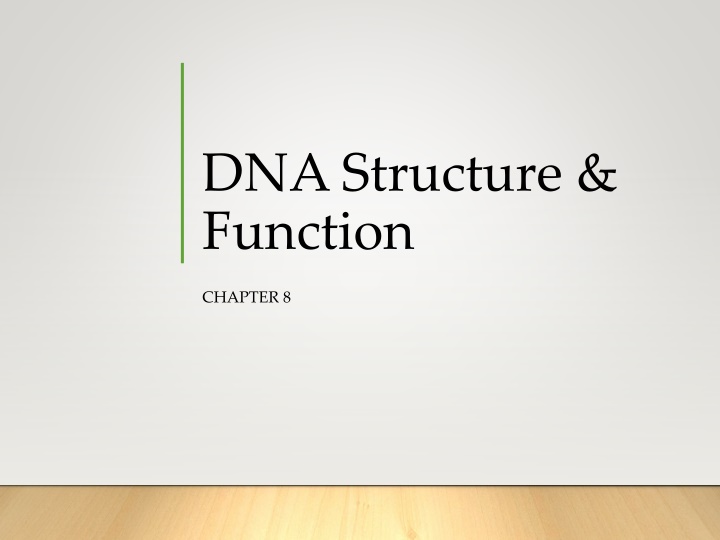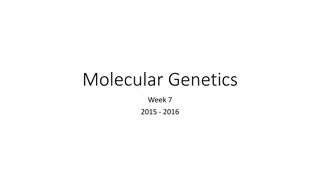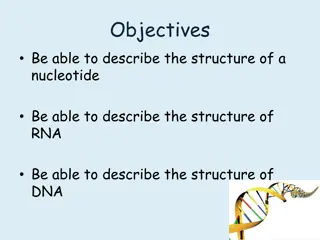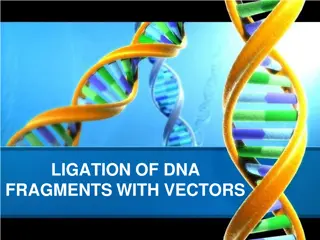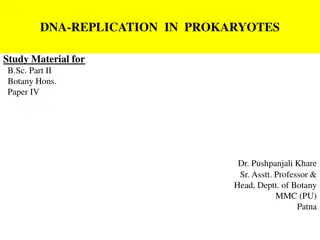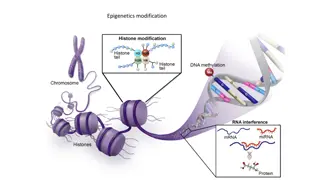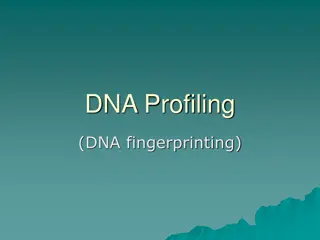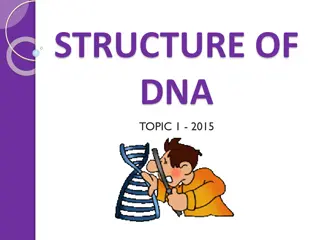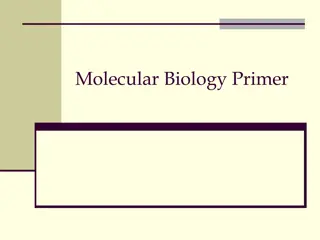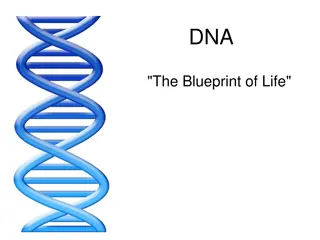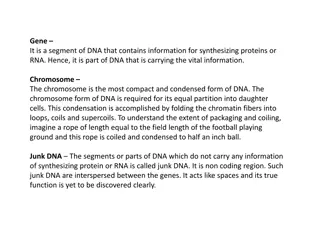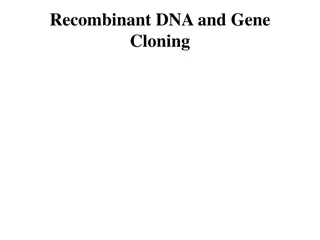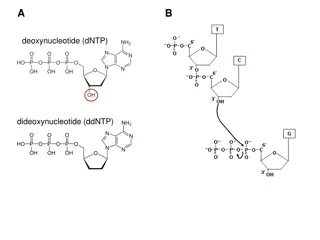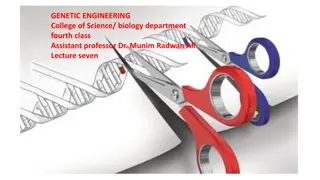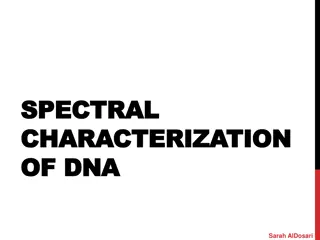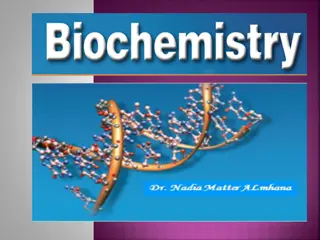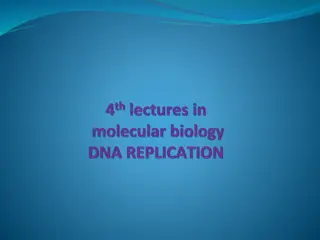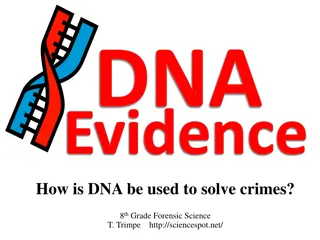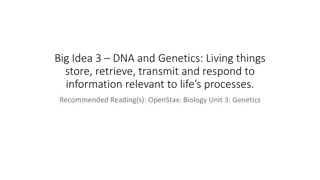DNA Discovery and Structure Milestones
In the fascinating journey of understanding DNA, key discoveries by scientists such as Johann Miescher, Frederick Griffith, and Oswald Avery paved the way for grasping DNA's role as the genetic material. The discovery of DNA's structure as the blueprint for living organisms, composed of nucleotides and nitrogen bases, marked a significant milestone. The establishment of Chargaff's rule by Erwin Chargaff and the groundbreaking work of James Watson and Francis Crick in the 1950s further solidified our knowledge of DNA's structure and function.
Download Presentation

Please find below an Image/Link to download the presentation.
The content on the website is provided AS IS for your information and personal use only. It may not be sold, licensed, or shared on other websites without obtaining consent from the author.If you encounter any issues during the download, it is possible that the publisher has removed the file from their server.
You are allowed to download the files provided on this website for personal or commercial use, subject to the condition that they are used lawfully. All files are the property of their respective owners.
The content on the website is provided AS IS for your information and personal use only. It may not be sold, licensed, or shared on other websites without obtaining consent from the author.
E N D
Presentation Transcript
DNA Structure & Function CHAPTER 8
Discovery 1869: Johannes Miescher Determined the substance we now call DNA was not a protein, but could not find function 1928: Frederick Griffith Found that one strain of bacteria could be transformed into another 1940: Oswald Avery, Colin Macleod and Maclyn McCarty Identified that the transforming principle was a nucleic acid
Discovery Late 1940s: Alfred Hershey and Martha Chase Established that DNA transmits a full complement of hereditary information 1948: Andr Boivin and Roger Vendrely Established that body cells of any individual of a species contain precisely the same amount of DNA Daniel Mazia s laboratory discovered that DNA content does not change over time
Discovery Evidence showed DNA met all the essential properties of hereditary material A full complement of hereditary information must be transmitted with the molecule from one generation to the next An equal amount of hereditary material must be found in each cell of a given species Hereditary material must not change in order to function as a genetic bridge between generations Must be capable of encoding the enormous amount of information required to build a new individual
Structure DNA: Deoxyribonucleic Acid Nucleic acid genetic material! Blueprint for living organisms! Passed from generation to generation! DNA is a polymer made of nucleotides, each with -- 1. five-carbon sugar deoxyribose 2. three phosphate groups 3. one of four nitrogen-containing bases Adenine, guanine, thymine, cytosine
DNA Nitrogen bases are either - Purines: double ringed bases Guanine (G) and Adenine (A) Pyrimadines: single ring bases Cytosine (C) and Thymine (T) 1950: Erwin Chargaff 1stRule: within a species the amount of guanine nearly equals the amount of cytosine, and the amount of adenine nearly equals the amount of thymine (A = T and G = C)
Structure 1950s: James Watson and Francis Crick suspect that DNA is a helix Rosalind Franklin made the first clear image of DNA as it occurs in cells using X-ray diffraction She calculated that DNA is very long and identified a repeating pattern Wilkins, Watson and Crick later stole this work and took credit for themselves, winning the Nobel Peace Prize
Structure The structure of DNA is called a double helix twisted ladder The phosphate of one nucleotide bonds to the sugar of another creating a backbone on the outside of the molecule [sides of the ladder] The nitrogen bases pair with each other on the inside [rungs of the ladder] The whole molecule is held together by hydrogen bonds
DNA A purine base always bonds to a pyrimidine, ensuring equal distance between the rails of the ladder Complementary base pairing each base will only bond with 1 other specific base A bonds to T [double hydrogen bond] Remember AT2 C bonds to G [triple hydrogen bond] Remember CG3 Order of bases in one strand determines the order of the bases in the other
DNA Chargaff s 2ndRule: The order of nucleotides in a strand of DNA, DNA sequence, varies tremendously among species Variations in nucleotide sequence are the foundation of life s diversity; defines species and distinguishes individuals
DNA The two sides of DNA are antiparallel meaning they are parallel to each other but are oriented in the opposite direction of each other Think of a 2 way street parallel, but traffic goes in opposite directions
DNA The last carbon atom on one end is the 5 [5 prime] carbon of a sugar and the last carbon atom on the other end is the 3 carbon of a sugar The direction of one strand is 5 to 3 and the other is 3 to 5
Chromosomes Chromosome: structure that consists of DNA and associated proteins Carries part or all of a cell s genetic information DNA is arranged in segments called genes Histone: protein that structurally organizes eukaryotic chromosomes Chromatin: Relaxed form of DNA in the nucleus
Chromosomes During most of a cell s life, each chromosome consists of one DNA molecule When the cell prepares to divide, it duplicates its chromosomes by DNA replication After replication, each chromosome consists of two DNA molecules (identical sister chromatids) that attach at a centromere region
Chromosomes Each species has a characteristic chromosome # (chromosomes in its cells) Human body cells have two sets of 23 chromosomes two of each type Karyotype: an image of an individual s diploid set of chromosomes
Chromosomes Autosome: chromosome that is the same in males and females Two autosomes of a pair have the same length, shape, and centromere location, and hold information about the same trait Sex chromosomes differ between males (XY) and females (XX)
DNA Replication For each cell to have a copy of DNA, the cell copies its chromosomes into two sets before dividing Before DNA replication, a chromosome has one molecule of DNA Semiconservative replication produces two copies of DNA: one strand of each copy is new, and the other is parental
Semiconservative Replication DNA helicase: enzyme responsible for unwinding and unzipping the double helix. Hydrogen bonds are broken creating two single strands Free floating nucleotides (in the nucleus) match up to the parent strands Each nucleotide provides energy for its own attachment to the parent strand of DNA Two of three phosphate groups are removed when a nucleotide is added
Semiconservative Replication DNA polymerase: attaches new nucleotides to each strand and proofreads Reads in 3 to 5 direction, attaches in 5 to 3 direction Both strands of the parent molecule are copied at the same time As each new DNA strand lengthens, it winds up with its template strand into a double helix
Semiconservative Replication The leading strand replicates continuously [5 3 ] The lagging strand replicates away from the fork [3 It is synthesized discontinuously in small segments Okazaki Fragments: about 100-200 nucleotides long 5 ] DNA Ligase: enzyme that seals gaps, so the new DNA strands are continuous
Semiconservative Replication In prokaryotic cells, DNA is a loop (circular) in the cytoplasm. The DNA strand is opened at one origin of replication Eukaryotic DNA unwinds in multiple areas during replication
Mutations Mistakes can and do occur during DNA replication The wrong base is added to a growing DNA strand, a nucleotide gets lost, or an extra one slips in Most replication errors occur because DNA polymerases work very fast, luckily, most proofread their work They can correct a mismatch by reversing the synthesis reaction
Mutations However, DNA polymerases do not copy damaged DNA very well If proofreading and repair mechanisms fail, an error becomes a mutation Mutation: a permanent change in the DNA sequence of a cell s chromosome
Mutations Mutations can form in any type of cell Those that occur in sex cells can be passed to offspring Some alter DNA instructions and may have a harmful or lethal outcome cancer Not all mutations are dangerous Some give rise to variation in traits; basis for evolution
DNA Damage Ionizing radiation from X-rays, most UV light, and gamma rays may cause DNA damage Breaks DNA Causes covalent bonds to form between bases on opposite strands Fatally alters nucleotide bases
Cloning Cloning: making an identical copy of something Reproductive Cloning: technology that produces genetically identical individuals Example: artificial embryo splitting Animal breeders using cloning because sometimes they want an exact copy of a specific individual
